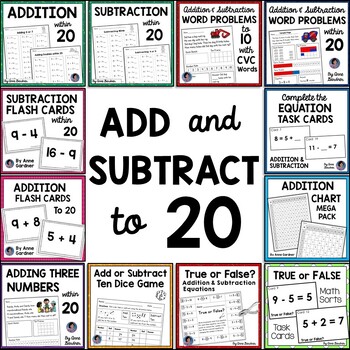Add & Subtract within (to) 20: Math Fact Fluency Worksheets & Word Problems
- Zip
- Internet Activities
- Easel Activity
What educators are saying
Products in this Bundle (15)
showing 1-5 of 15 products
Description
This First Grade Math Bundle includes Word Problems, Systematic Math Fact Fluency Practice, Complete the Equation Practice, Math Fact Flash Cards, Work with True or False Equations, Addition Chart Activities and More!
Browse through over 150 pages in the previews so you can buy with confidence!
To see detailed descriptions and customer comments regarding each of these products, please click on the following links:
★ Word Problems: Addition and Subtraction within Ten
★ Word Problems: Addition and Subtraction within Twenty
★ Word Problems: Addition with Three Addends
★ Math Fact Fluency: Addition within Twenty
★ Math Fact Fluency: Subtraction within Twenty
★ True or False Equations: Hole punch activity
★ Add or Subtract Ten Dice Game
★ Addition Facts to 20 Flashcards: Ideal for Building Math Fact Fluency
★ Subtraction Facts to 20 Flashcards for 1st & 2nd Grade Math Fact Fluency
★ 20 Tic Tac Toe Games: Math Fact Fluency Practice
★ Addition and Subtraction within 20: Complete the Equation Task Cards
When approaching word problems, students are presented with multiple ways to solve each problem.
Once students are familiar with the ways these sheets support their problem solving, I often have each student choose two ways to show and check their work.
This allows each student to utilize the methods that are most efficient for him/her. I love to give students time to discuss why they chose certain methods to solve a problem!
A bonus question for enrichment/extension is included with each problem. These bonus questions are perfect extension activities for students to discuss and complete at home with a family member.
Many parents have commented that they appreciate the challenging nature of these questions.
When these word problems are used for whole-group instruction, it is common for some students to have completed tasks while others still need support. “Early finishers” can read the bonus question, flip their paper over and work on the challenge question while the teacher provides individual and/or small group instruction as needed.
In this way, these bonus questions help teachers differentiate during group lessons.
The addition and subtraction fact fluency practice sheets are designed to help students develop confidence and fluency with addition facts. On each page, there are 3 columns of problems.
These sheets are designed to make it easy to differentiate. Upon the teacher’s directions, a child can fold the 3rd column over and “complete” the task by answering the questions in the first two columns.
All of these resources are designed with the rigor of the Common Core in mind.
Thanks for stopping by and taking a look. Best wishes for a wonderful school year!
Sincerely, Anne Gardner (National Board Certified Teacher)
*******************************************************************************************************
Also Known As:
1st & 2nd Grade Word Problems to 20: Addition and Subtraction Fluency Worksheets
Also Available:
250 Reading Comprehension Passages and Questions for Guided Reading Levels C - P
1st Grade Math Word Problems to 20: Addition and Subtraction Fluency Worksheets
1st Grade Math Fact Fluency Worksheets: Add & Sub to 20 Plus Word Problems {RTI}





